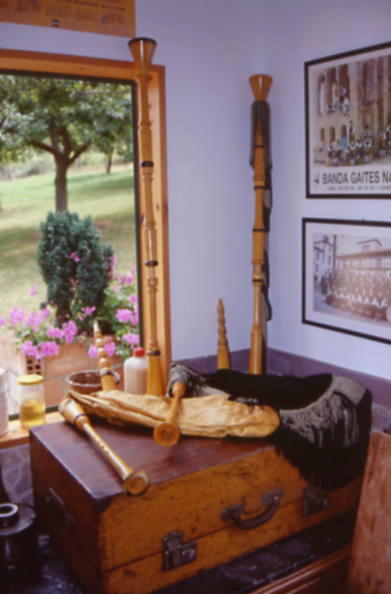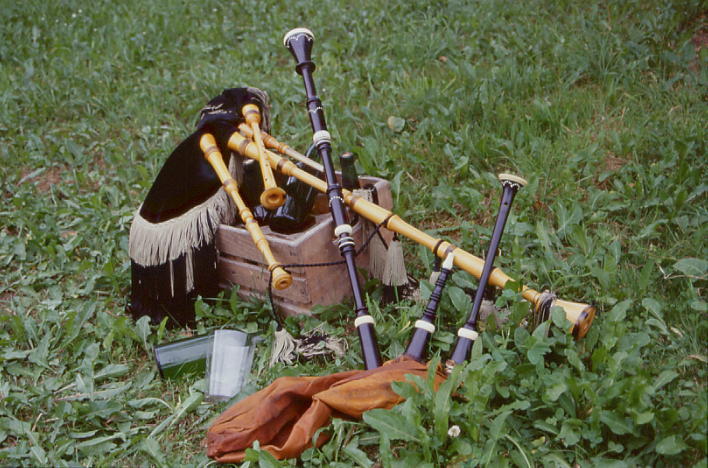|
|||||||

"We owe to Alberto Fernández Velasco the revolution of transforming the rustic traditional asturian pipe into a respected musical instrument which deserves to be taken into account in the High Conservatories.../...his name should be pointed out in the history of the asturian traditional culture" José Mª Marcilla |
||
|
||
"...the famous pipe maker Alberto Fernández Velasco makes his instruments with the care, the art and the good work of the artisan together with the exactness and the scientific method..." Ramón F. Avello - Newspaper El Comercio '93 |
||
20 YEARS OF RESEARCH ON THE ASTURIAN PIPES
Since he was very young, Alberto loved pipe playing. It was after years of working as cabinetmaker that he discovers his real vocation making pipes.
He makes his first asturian bagpipe -gaita- in 1980, copying on an instrument made by the ancient artisan Gaitero de Arroes, which he tried to improve. And he really did it, as this new bagpipe met a great success in a Fair in Oviedo this same year, a success that encourages him to work harder on the instrument.
 Paying no attention to
critics, he follows his own criterion and begins to research on
the pipe, trying to improve its timbre and tone
characteristics. At the same time, he is capable of
keeping the typical asturian timbre of the bagpipe, something
that he considers to be the essence of its sound, following the
tradition.
Paying no attention to
critics, he follows his own criterion and begins to research on
the pipe, trying to improve its timbre and tone
characteristics. At the same time, he is capable of
keeping the typical asturian timbre of the bagpipe, something
that he considers to be the essence of its sound, following the
tradition.
He starts to study the pipes made by the old asturian artisans, such as El Cogollu, Solares, Marcelo Fresnu, Manolín de la Carrera, José la Piedra, the Gaitero Margolles, ... , but he perfects both the exterior and the inner concept of all different kind of asturian pipes: "grilleras", "redondas" and "tumbales". He reachs, for the very first time, to make them sound in perfect diatonic scales - D, sharp C, C, B and flat B - something extraordinary at that moment.
A new era for the asturian pipe begins with the technical improvements reached by the artisan.
In the early 80's, he is also capable to make similar instruments, ready to be played together. This "similarity" allows the creation of the first asturian Pipe Bands. One of them, leaded by the piper Xuacu Amieva, wins the first prize in a band competition held in Oviedo in 1982, playing the instruments designed by Alberto F. Velasco.
On the other hand, and thanks to their really high musical quality, these brand new pipes, played by the best master pipers, have gained the popular recognition to their musical characteristics, even sharing stage with symphonic instruments. They have also been played by some popular folk groups like Xaréu and Ubiña, among others.
 Many asturian pipers
have won important competitions, such as the McCallan
Prize in the Interceltic Festival of Lorient, playing the
instruments made by the artisan, both in Spain and abroad.
Among them, it is important to point out José Manuel Tejedor,
Jorge Areces, Alberto Varillas, José Angel Hevia or
Javier Tejedor.
Many asturian pipers
have won important competitions, such as the McCallan
Prize in the Interceltic Festival of Lorient, playing the
instruments made by the artisan, both in Spain and abroad.
Among them, it is important to point out José Manuel Tejedor,
Jorge Areces, Alberto Varillas, José Angel Hevia or
Javier Tejedor.
Aware of the importance of creating a chromatic bagpipe, he starts to work on it very hard during the 90's until he designs a chanter with an extension of one octave and a half. After adding a small drone to it and improving the chanter, this new bagpipe can play 2 chromatic scales. The prototype is submitted to examination by the High Conservatory of Music "Eduardo Martínez Torner" of Oviedo (Asturias). The final report can not be better, talking about an "excelent quality of the sound" and emphasizing the outstanding improvements made by Alberto on this traditional instrument.
Following to it, the chromatic bagpipe becomes in 1993 the center of the Asturias Day Concert. One year later, it played the main role as soloist instrument of the album "Día de Fiesta n'Asturies", sponsored by the asturian Government. At both ocassions, his son, the famous piper Alberto Varillas, is the piper in charge of taking out the most of this pipe, showing all its brilliant musical possibilities.
During these years the artisan has been awarded several times for his work of research and study. It is important to point out the 1989 and 1998 editions of the Prize "Urogallo de Bronce" in the handycraft category, conceded by the Asturian Centre in Madrid, as well as many other recognitions to his work organised by the Town Councils of Oviedo, Gijón or El Entrego. The last one, shared with some other asturian pipers, took place on April 14, 1999, in the Jovellanos Theatre of Gijón.
Far away from prizes, Alberto F. Velasco works hard every day in his workshop of Santurio (Gijón), producing his requested hand-made pipes, and looking for new ways of improvement for the asturian bagpipe.
| All the instruments made in this workshop are completely hand-made, and the artisan works on them with the highest care during all the process, going from the selection of best woods - basically ebony and boj-, to the dress making. It is thanks to this special care and the meticulous work of the most popular pipemaker in Asturias, that the pipes are given ready to be played and have a musical quality beyond compare. |

Nowadays, his hand-made production is focused on the C and natural B asturian pipes, though he counts on his own prototypes of the sharp C, D and flat B instruments, as well as the unique prototype of the Chromatic Asturian Bagpipe.

| To contact the artisan: |
| Alberto Fernández Velasco |
| C/Quevedo, 19-3ºA principal |
| 33204 Gijón (Spain) |
| tel: +34-985371835 |
Designed by itel69